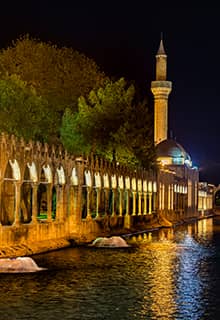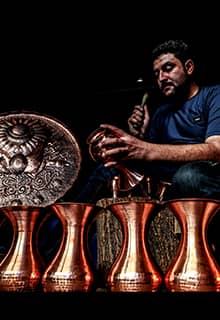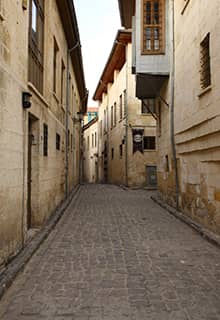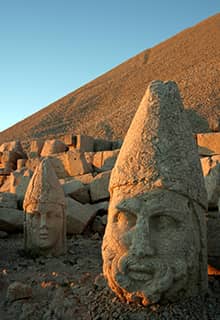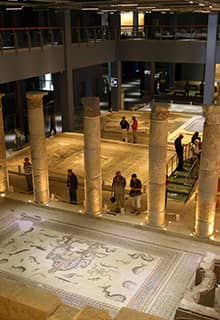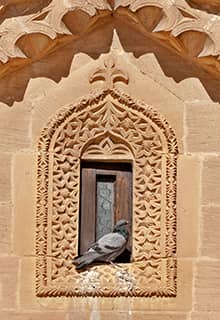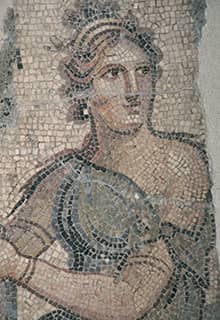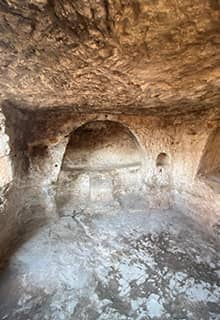

touch
South Eastern Türkiye
Birecik in Şanlıurfa
The city rises on the western bank of the Euphrates River, with some developments on the opposite side of that waterway. Its name may come from “Birtho”, which means “hill” in Assyrian. There is no trace of such a hill nowadays, but the archaeologists suspect that the fact that only one of the twelve bastions that defended the castle exists could indicate the past existence of an elevation.
It’s an old city, founded in around 2000 BCE, although there is not much left of its oldest past. It was ruled by Hittites, Assyrians, Persians, Byzantines, and Arabs. It was known to the Crusaders, was destroyed by Timur in the 14th century.
Visitors should pass through the old castle, walking along its walls, where the most picturesque part of the city is. Bird lovers come to Birecik to see the colony of the northern bald ibis, known here as Kelaynak. This species is almost extinct, but in Birecik you can easily spot them between February and July.
The ancient cemetery from the early Bronze Age is also a must-see, which was used for 500 years and where more than 300 tombs were excavated between 1997 and 1998.
Midyat in Mardin
Midyat is located in the province of Mardin and has a population of about 60,000 people and a history that gets lost in the depths of time. It’s mentioned in Assyrian inscriptions in the 9th century BCE under the name Matiate and since that time was part of several empires and kingdoms having been ruled by Assyrians, Armenians, Medes, Persians, Greeks, Romans, Byzantines, Arabs and Ottomans.
Its historic centre seems like something out of the tales of the Arabian Nights. A world made up of alleys lined with old houses adorned with carved stone, fabulous bazaars, and Muslim and Christian temples that you’ll come across at the most unexpected spots.
If you can, visit the monastery of Mor Abrahom Hobel, near the historic centre, but be aware that it may be closed.
Karkamış Ancient City in Gaziantep
The most powerful of the Late Hittite Kingdoms, established in 300 years following the fall of the Hittite Empire towards the beginning of the 12th century BC, is the Kingdom of Carchemish. Carchemish came under the influence of the Hittites, who captured the city Aleppo and most of Syria in the second half of the 17th century BC. After the fall of the Hittite Empire around 1,195 BC, Carchemish became one of the strongest independent kingdoms of the region. The city was destroyed by the Assyrian Sargon II in 717 BC. The settlement in the city continued during the Hellenistic and Roman periods, but afterwards it rapidly lost its importance and was abandoned.
As a result of the excavations, many new hieroglyph Luwian inscriptions, clay tablets, graceful walking lion, winged bull and winged goat-bull reliefs, mosaic floors, were unearthed. The reliefs, mainly from the Late Hittite period, the depictions of the goddess Kubaba and the procession of soldiers, priests, people carrying various animals, princes armed with long and straight swords, chariots, mixed creatures, and guard animals, shed light on the lifestyle, clothing and culture of the early first millennium BC. Most of the Karkamış reliefs are exhibited in the Ankara Anatolian Civilizations Museum and the Gaziantep Archeology Museum today. Karkamış Ancient City will soon be opened to visitors as an "Archeopark."
The Monumental Mosques and Churces in Diyarbakır
Ulu Mosque, built by the Seljuk Sultan Melik Şah, is notable for its original design and for its utilization of both Byzantine and more ancient architectural materials. The mihrap (prayer niche showing the direction to Mecca) of the nearby Mesudiye Madrasah is made of the local black basalt. The Nebii Mosque represents the typical Ottoman style, while the Safa Mosque exhibits Persian influences on its tiled minaret. The third century Aramaic Church of the Virgin Mary (Meryemana Kilisesi), which is still in use today, also makes for an interesting visit.
Cendere Bridge (Köprüsü) in Adıyaman
The Cendere Bridge is also known as the Roman Bridge or Septimius Severus Bridge. It is located on the Ancient Cabinas (Cendere) Stream. This name is given because the bridge connects the two sides of the stream flowing through a magnificent canyon. The bridge was built by XVI, who established a headquarters in Samsat (Somasata) at that time by the order of the Roman Emperor Septimius Severus (AD 193-211). It was built by the Legion.
Cendere Bridge is a magnificent monumental example of Ancient Roman architecture. Consisting of two arches, one main arch and one evacuation arch, the bridge is made of smooth cut stones, each weighing tons. The most interesting architectural feature of the bridge, which is 7 meters wide, 30 meters high and 120 meters long, is that it was built without mortar.
The bridge rises in the form of a ramp from both sides and joins in the middle. This feature increases the static strength of the bridge and gives the bridge a monumental appearance.
Hasankeyf Castle (Kalesi) in Batman
Hasankeyf Castle, which is made one piece stone, is on the banks of the Tigris River and 200 meters above the river. It was built in 363 A.D. by the Byzantines as the headquarters of an Assynese diocese. After the spread of Christianity in this region, the Diocese in Hasankeyf was given the title of Cardinal by a decision of Kadıköy Consul in 451 AD. Very sheltered and difficult to capture, this castle is the most solid and durable castle the Byzantines have built in the east.
Hasankeyf Castle has two gates. The door to the east is called İmam Abdullah Gate, and the door to the west is called The Gate of Secrets (Sır Kapısı). It is possible to reach the castle via stairs. There are many inscriptions on the castle walls. To bring water to the castle, one open and one hidden way were built between river and castle. These stairways have 200 steps, and they are still very solid.
Mausoleum of Noah (Hz. Nuh Türbesi) in Şırnak
The mausoleum of Noah, the second father of humanity since the flood, is located in the mosque, which called with the same name. Both the shrine and the mosque have been restored in recent years.
The place where Noah was buried was first converted into a synagogue, then a church and a mosque in 639. This shrine is one of the oldest in the world.
The famous historian İbnülesin Firuzabadi, Evliya Çelebi, Katip Çelebi, Ebubekir Helevi and Babilli Berassus (Bersis) write that this tomb belongs to Noah. The tomb of Al Jazeera, the founder of cybernetics, is also inside this mosque.

